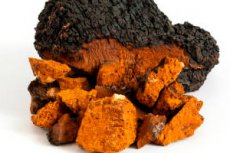New data on the mechanisms of the fight against oral cancer by the chaga mushroom
Last reviewed: 14.06.2024

All iLive content is medically reviewed or fact checked to ensure as much factual accuracy as possible.
We have strict sourcing guidelines and only link to reputable media sites, academic research institutions and, whenever possible, medically peer reviewed studies. Note that the numbers in parentheses ([1], [2], etc.) are clickable links to these studies.
If you feel that any of our content is inaccurate, out-of-date, or otherwise questionable, please select it and press Ctrl + Enter.

In a recent study published in Scientific Reports, researchers examined the mechanisms of antitumor activity of chaga mushroom extracts in human oral cancer HSC-4 cells.
Oral cancer is a global health problem with limited treatment options due to its side effects and sequelae. The main treatments are surgery, radiation therapy and chemotherapy, although these can cause damage to healthy tissue, affect speech and reduce quality of life.
Understanding and targeting metabolic pathways in tumor cells provides a possible avenue for the development of new therapeutic agents. Chaga mushroom has anti-cancer properties against several types of cancer; however, the mechanism is not clear.
In this study, researchers tested whether the chaga mushroom affects the development and metabolism of oral cancer.
After treatment with the mushroom extract, the researchers studied cell survival, proliferation ability, glycolytic pathways, apoptosis, and mitochondrial respiration mechanisms.
They treated HSC-4 cells with fungal extract at doses of 0 μg/ml, 160 μg/ml, 200 μg/ml, 400 μg/ml and 800.0 μg/ml for a day to evaluate its effect on oral cell behavior. Malignant tumor, including cell cycle, proliferation, viability, mitochondrial respiration, apoptosis and glycolysis.
The team analyzed the treated cells in terms of their cell cycle, using Cell Counting Kit-8 (CCK-8) assays to determine cell viability.
To investigate whether the suppressive effects of chaga mushroom on tumor proliferation and survival in treated cells involve signal transducer and activator of transcription 3 (STAT3), they measured STAT3 activation after treatment with a dose of 200.0 μg/ml extract.
They also performed flow cytometry to analyze cell distribution and Western blotting to extract total cellular proteins.
Researchers used liquid chromatography followed by tandem mass spectrometry (LC-MS) to identify the components responsible for the anticancer properties of chaga mushroom extract.
Concentrations of candidate compounds were determined using high-performance liquid chromatography with a photodiode detector (HPLC-DAD).
They examined the regulation of glycolysis by extracts among treated cells using an extracellular acidification rate (ECAR) assay. They recorded real-time ECAR measurements in treated cells after administration of glucose, oligomycin, and 2-deoxy-D-glucose (2-DG).
The team examined the activation of an energy sensor called adenosine monophosphate-activated protein kinase (AMPK) and the cellular oxygen consumption rate (OCR).
They also assessed the effect of chronic energy deficiency on autophagy associated with apoptotic cell death in treated cells.
They studied whether a concentration of chaga extract of 200.0 μg/ml affected apoptosis stimulated by p38 mitogen-activated protein kinases (MAPKs) and nuclear factor kappa B (NF-κB) in treated cells.
The extract slowed down the growth of HSC-4 cells by inhibiting the cell cycle and proliferation, reducing the energy consumption of cancer cells, and increasing cell death through autophagy and apoptosis.
The extract significantly increased the growth phases of oral cancer cells (G0/G1), while simultaneously decreasing the synthesis phase (S). In a Western blot study, it was found that the extract significantly reduced phospho-STAT3 expression after 15 minutes and maintained it for 120 minutes.
LC-MS identified three possible anticancer substances: 2-hydroxy-3,4-dimethoxybenzoic acid, syringic acid and protocatechuic acid. The extract inhibited glycolysis, glycolytic capacity and glycolytic reserves in treated cells.
It also activated AMPK, promoting autophagy and inhibiting glycolytic pathways in treated cells. Induction of autophagy by the extract showed a dose-dependent increase in basal mitochondrial respiratory rates and adenosine triphosphate (ATP) turnover.
However, no significant changes in maximum mitochondrial respiratory rates were observed, except in cases with the highest extract concentration. In addition, the researchers observed a dose-dependent significant decrease in mitochondrial respiratory reserve capacity.
The results showed that chaga mushrooms reduced mitochondrial membrane potentials in treated cells through persistent autophagy driven by inhibition of glycolysis, implying that mitochondrial dysfunction causes apoptosis.
Activation of NF-κB and p38 MAPK by extract increased apoptosis. The extract increased early apoptosis of treated cells in a dose-dependent manner.
However, no significant differences in late apoptosis were observed at extract concentrations from 0 to 400 μg/ml. High doses of chaga extract may affect other cell physiologies and reduce maximum mitochondrial respiratory capacity.
Researchers found that chaga extract suppressed mitochondrial membrane potentials and glycolytic activity in the HSC-4 cell line, resulting in decreased ATP levels and autophagy.
Activation of AMPK had effects by inducing autophagy. Dephosphorylation of STAT3 inhibits the cell cycle by stimulating apoptotic pathways through activation of NF-κB and p38 MAPK.
Various cell signaling mechanisms mediated the extract's inhibitory effects. The extract contained three anti-cancer compounds: 2-hydroxy-3,4-dimethoxybenzoic acid, syringic acid and protocatechuic acid.
Although more preclinical studies are needed to determine whether the extract inhibits tumor growth, the study results imply that the mushroom extract may be a potential complementary therapeutic agent for the treatment of patients with oral cancer.
